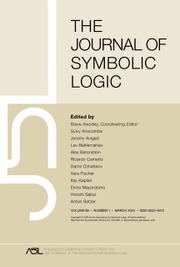No CrossRef data available.
Article contents
Logic, sheaves, and factorization systems
Published online by Cambridge University Press: 12 March 2014
Extract
In this paper we extend the models for the “logic of categories” to a wider class of categories than is usually considered. We consider two kinds of logic, a restricted first-order logic and the full higher-order logic of elementary topoi.
The restricted first-order logic has as its only logical symbols ∧, ∃, Τ, and =. We interpret this logic in a category with finite limits equipped with a factorization system (in the sense of [4]). We require
(in the sense of [4]). We require  to satisfy two additional conditions:
to satisfy two additional conditions:  ⊆ Monos, and any pullback of an arrow in
⊆ Monos, and any pullback of an arrow in  is again in
is again in  . A category with a factorization system satisfying these conditions will be called an EM-category.
. A category with a factorization system satisfying these conditions will be called an EM-category.
The interpretation of the restricted logic in EM-categories is given in §1. In §2 we give an axiomatization for the logic, and in §§3 and 5 we give two completeness proofs for this axiomatization. The first completeness proof constructs an EM-category out of the logic, in the spirit of Makkai and Reyes [8], though the construction used here differs from theirs. The second uses Boolean-valued models and shows that the restricted logic is exactly the ∧, ∃-fragment of classical first-order logic (adapted to categories). Some examples of EM-categories are given in §4.
The restricted logic is powerful enough to handle relations, and in §6 we assign to each EM-category  a bicategory of relations Rel(
a bicategory of relations Rel( ) and a category of “functional relations”
) and a category of “functional relations”  fr.
fr.  fr is shown to be a regular category, and it turns out that Rel(
fr is shown to be a regular category, and it turns out that Rel( and Rel(
and Rel( fr) are biequivalent bicategories. In §7 we study complete objects in an EM-category
fr) are biequivalent bicategories. In §7 we study complete objects in an EM-category  where an object
where an object  of
of  is called complete if every functional relation into
is called complete if every functional relation into  is yielded by a unique morphism into
is yielded by a unique morphism into  . We write
. We write  c for the full subcategory of
c for the full subcategory of  consisting of the complete objects. Complete objects have some, but not all, of the properties that sheaves have in a category of presheaves.
consisting of the complete objects. Complete objects have some, but not all, of the properties that sheaves have in a category of presheaves.
Information
- Type
- Research Article
- Information
- Copyright
- Copyright © Association for Symbolic Logic 1993

